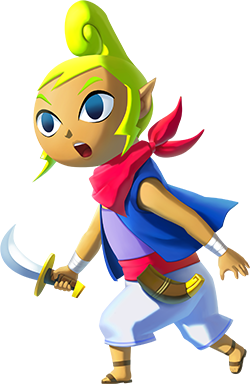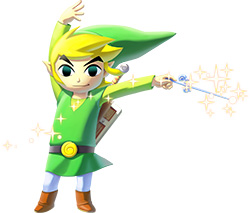Link: one of the longest lasting and most beloved icons in the interactive media world. An almost eternal boy, constantly saving the world at the last moment from Ganondorf's evil schemes, in which Princess Zelda is always involved, to a varying extent. Most often, she is the recipient of some form of legendary power and the key to controlling the TriState Area Triforce.
We've heard this story six times already (counting only Nintendo home console versions), with different variations. However, in terms of gameplay, evolution was limited to the first four games. Zelda II was a significant departure from the original, Super Zelda improved Zelda's top-down exploration almost to perfection, and Zelda 64 changed the way 3D adventure games were built. However, from Zelda 64 on, little has changed. Each game in the series would get its defining characteristic/mechanic, but general story, controls, menus or items remained pretty much the same.
Late Beginnings
I love A Link to the Past as much as anyone, even though I never finished it. It had good puzzles, tricky dungeons and awesome dungeon bosses. What made boss fights so good was the fact that they were difficult, until you learnt the method. After attacking the enemy three or four times, each with a little higher difficulty, the game acknowledged you as the winner. No five minutes battles, no constant die and retry, no rinse and repeat. This, for me, is the defining mark in the Zelda genre, and its greatest gift to computer game design. It is recognizable in every Zelda game afterwards, but also in the Metroid saga, Soul Reaver or Beyond Good & Evil.
 |
| The Light World |
In other aspects, the game always felt quick, even when you were stuck. The moment you entered a room you easily identified every relevant item in seconds. Killed some minions, activated a switch and moved to the next area. Opened a chest, saw a 2 seconds description and moved on. Killed a boss, collected a heart and an object, got out of the dungeon in seconds and moved on. Every action was snappy and the game was constantly pushing you forward, with short conversations and a very streamlined interface.
Basically, Super Zelda kept the obstacles between the player and the actual Hyrulean struggle to a minimum.
Evolution comes at a cost
Seven years later came The Legend of Zelda: Ocarina of Time. Three dimensions opened many new opportunities and challenges and Ocarina of Time was the first game to find an appropriate balance between camera freedom and combat precision. Its lock mechanism proved to be a very effective solution, finding its way into almost every three dimensional adventure game, plus the Metroid Prime series.
| Lock-on or Z-Targeting in Ocarina of Time |
But disregard the graphics and camera management, and you will find Super Zelda all around. Same platforming mechanism, multi-menu system, main and secondary weapons, dungeon schemes and items or contextual buttons. Some new aspects were introduced, like ocarina playing (precursor to Guitar Hero?) or adapted to the new console, like the new C-pad sub-weapon management. But the immediacy of the 2D Zelda was lost: the number of times you have to change sub-weapons is reduced, but, each time, you face a slow menu and a button re-mapping. The experience became one in which the player makes a great effort to reduce the need to enter the menu to a minimum. The snappiness of exploration was also lost: in Ocarina of Time a player will spend half of the total play time looking around, identifying interactive objects, aiming and opening chests. All of these actions are slow to perform, almost to desperation. The chest opening sequence is specially guilty. It lasts at least 10 seconds, and every time you pick an object it is described. To make things worse, the chest opening music is the same it always was, so it ends way before the text dissapears.
Unfortunately, this became Zelda 64's legacy: zero menu agility and constant pauses to aim, change equipment or talk to patronizing NPCs.
Puzzles, as well as in Super Zelda, are repetitive in each dungeon, but are now encumbered by the slow aiming and menu systems. Particularly dreadful in Ocarina of Time and the following Zelda games is the grappling hook. Shooting it a hundred times per temple is so boring that I cannot help but wonder why wouldn't the design team devise some faster or automated way to perform an equivalent action. My best guess is that it was on purpose: increasing play time through repetition was an important aspect in the game design.
Stalled ideas
The following games, Wind Waker and Twilight Princess, kept all the crippling features, only adding some new mechanics and items.
Unbelievably, wind changing and sailing were even worse than usual, forcing the player to play a tune almost every time the boat needed to head in another direction. A single button for hoisting the sail, and one of the analogs to direct wind would have improved the situation greatly. It is sadly telling that the biggest change Wind Waker introduced in the series was the boomerang, which added little to the bow and clawshot and could have replaced both easily. It didn't, so the number of sub-weapon changes required to end the game was increased for no good reason.
Instead of streamlining items, reducing their count, the team preferred focusing on adding new items with one defining ability, even if secondary ones were duplicated. Through the years, Zelda has become the clearest example of feature creep in a series. Nintendo's inability to reconsider legacy designs is disheartening.
And as in Zelda 64, the adventure consisted of forty hours of travels executing irritatingly repetitive, menial, long tasks, solving over-simplified puzzles and generally not having much fun. Too often, the reward is only in finishing the mission at hand, but not in the execution, nor its overall relevance.
On the other hand, Twilight Princess at least had the decency to make shape-shifting, a very common action during the story, accessible with just two button presses. However, after Symphony of the Night, more than one button for such a usual operation seems prehistoric. The rest remained pretty much unchanged.
 |
| Midna riding wolf Link |
Regarding character design, the other important aspect of Wind Waker was the radical revision of Zelda. Historically a Peach-style princess, barely able to do more than being a kidnapper's easiest target, Wind Waker's Zelda was a stronger character than Link himself. That is not hard, sure, but the designers excelled at creating an interesting female character. Until she was turned into an actual princess and suddenly rendered helpless, useless and pitiable. Wind Waker also introduced a dose of humour and tenderness that made its shortcomings less aggravating.
 | |
| Tetra, Zelda's incarnation in Wind Waker and Phantom Hourglass |
Twilight Princess, of course, introduced little change. Strong-Zelda was replaced with Midna, a relatively funny companion, bringing back the old, weak Princess.
And what about the Future?
Complains regarding the repetitive nature of the series have been heard often lately. Many fans like things as they are now, but there are more people who want the innovative Nintendo to return. Unfortunately, Nintendo has been happily recycling proved concepts since the Nintendo 64 era, only adding little touches of polish here and there, plus one or two new ideas per game. This design principle ensures high quality results and huge doses of nostalgia, but sacrifices creativity and surprise. Every 3D Mario and Zelda plays pretty much the same, with pretty much the same concepts.
To break the bubble Zelda has been living in for the last decade, Nintendo would have to look around and study its pupils. In my opinion, Soul Reaver nailed almost every design choice, but it is not the only one to have surpassed the master.
Only by accepting the shortcomings in Zelda games and looking for acceptable solutions will Nintendo get me interested in the series again. Aonuma promised to apply all his effort in rejuvenating the franchise, but after two major attempts little hope is left. Only the portable versions of Zelda have tried new approaches, but still failed at bringing down the chains linking them to their now 20 and 12 years old ancestors. And in a blooming industry, 12 years encompass 3 different generations of hardware, a couple genres birth and death and an infinite number of paradigm shifts.
Conclusion
After the first two games for the NES, which I chose to elide, A Link to the Past was a step in the right direction, establishing a reference for 2D adventure gaming. Ocarina of Time made 3D navigation and combat look easy, but covered that fluid experience with crippling interfaces and cutscenes. Afterwards, any hope of seeing something new come out of the franchise vanished. Link changed his clothing to great effect, but his heart and guts were just the same.
Meanwhile, adventure games have trodden new grounds for 10 years. No matter how young Link seems to be, he is relic of times past, refusing to let a new breed take control over.
 |
| Not a great fan of the series, am I? |

No comments:
Post a Comment